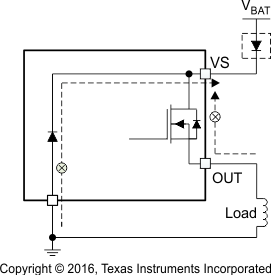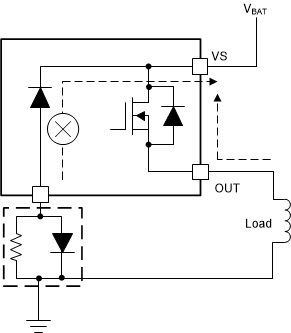SLVSD74D December 2015 – December 2019 TPS2H160-Q1
PRODUCTION DATA.
- 1 Features
- 2 Applications
- 3 Description
- 4 Revision History
- 5 Device Comparison Table
- 6 Pin Configuration and Functions
- 7 Specifications
-
8 Detailed Description
- 8.1 Overview
- 8.2 Functional Block Diagram
- 8.3 Feature Description
- 8.4 Device Functional Modes
- 9 Application and Implementation
- 10Power Supply Recommendations
- 11Layout
- 12Device and Documentation Support
- 13Mechanical, Packaging, and Orderable Information
Package Options
Mechanical Data (Package|Pins)
- PWP|16
Thermal pad, mechanical data (Package|Pins)
- PWP|16
Orderable Information
8.3.7.4 Reverse-Current Protection
Reverse current occurs in two conditions: short to battery and reverse polarity.
- When a short to the battery occurs, there is only reverse current through the body diode. IR(1) specifies the limit of the reverse current.
- In a reverse-polarity condition, there are reverse currents through the body diode and the device GND pin. IR(2) specifies the limit of the reverse current. The GND pin maximum current is specified in the Absolute Maximum Ratings.
To protect the device, TI recommends two types of external circuitry.
- Adding a blocking diode. Both the IC and load are protected when in reverse polarity.
- Adding a GND network. The reverse current through the device GND is blocked. The reverse current through the FET is limited by the load itself. TI recommends a resistor in parallel with the diode as a GND network. The recommended selection are 1-kΩ resistor in parallel with an >100-mA diode. If multiple high-side switches are used, the resistor and diode can be shared among devices. The reverse current protection diode in the GND network forward voltage should be less than 0.6 V in any circumstances. In addition a minimum resistance of 4.7 K is recommended on the I/O pins.
 Figure 34. Reverse-Current External Protection, Method 1
Figure 34. Reverse-Current External Protection, Method 1  Figure 35. Reverse-Current External Protection, Method 2
Figure 35. Reverse-Current External Protection, Method 2